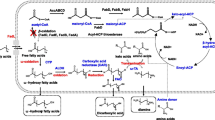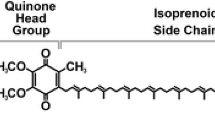Abstract
Biocatalysis using oxygenase or desaturase enzymes has the potential to add value to native fats and oils by adding oxygen, hydroxyl groups, or double bonds to create regio- and/or stereospecific products. These enzymes are a subset of the large class of oxidoreductase enzymes (from EC subgroups 1.13 and 1.14) involved with biological oxidation and reduction. In vitro biocatalytic processing using these enzymes is hampered by the high cost of the stoichiometric cofactors. This article reviews recent progress in developing in vitro redox enzyme biocatalysis for commercial-scale syntheses. Coenzyme recycling and electrochemical redox cycling as methods for cofactor regeneration are described and commercial applications indicated. Direct charge transfer without use of mediators is described as the cleanest way of introducing the reducing power into the catalytic cycle. Our electrochemically driven cytochrome P450cam bioreactor is discussed as an example of direct charge transfer to a redox protein. Site-directed mutagenesis in the active site of the P450cam monooxygenase greatly improved performance for the conversion of the nonnative substrate, styrene to styrene oxide. This epoxidation reaction was also shown to give a single product (styrene oxide) in the bioelectrochemical reactor when the diatomic oxygen co-substrate was managed properly.
Similar content being viewed by others
References
Shanklin, J., and E.B. Cahoon, Desaturation and Related Modifications of Fatty Acids, Annu. Rev. Plant Physiol. Plant Mol. Biol. 49:611–641 (1998).
Lipscomb, J.D., Biochemistry of the Soluble Methane Monooxygenase, Annu. Rev. Microbiol. 48:371–399 (1994).
Lee, L.G., and G.M. Whitesides, Enzyme-Catalyzed Organic Synthesis: A Comparison of Strategies for in Situ Regeneration of NAD from NADH, J. Am. Chem. Soc. 107:6999–7008 (1985).
Whitesides, G.M., and C.H. Wong, Enzymes as Catalysts in Organic Synthesis, Ang. Chem. Int. Ed. 24:617–718 (1985).
Rover, L., Jr., J.C.B. Fernandes, G. de Oleverio Neto, L.T. Kubota, E. Katekawa, and S.H.P. Serrano, Study of NADH Stability Using Ultraviolet-Visible Spectrophotometric Analysis and Factorial Design, Anal. Biochem. 260:50–55 (1998).
Chenault, H.K., and G.M. Whitesides, Regeneration of Nicotinamide Cofactors for Use in Organic Synthesis, Applied Biochem. Biotechnol. 14:147–197 (1987).
Devaux-Basseguy, R., A. Bergel, and M. Comtat, Potential Applications of NAD(P)-Dependent Oxidoreductases in Synthesis: A Survey, Enzyme Microb. Technol. 20:248–258 (1997).
Brielbeck, B., M. Frede, and E. Steckhan, Continuous Electroenzymatic Synthesis Employing the Electrochemical Enzyme Membrane Reactor, Biocatalysis 10:49–64 (1994).
Bommarius, A.S., M. Schwarm, and K. Drauz, Biocatalysis to Amino Acid-Based Chiral Pharmaceuticals—Examples and Perspectives, J. Molec. Catalysis B. Enzymatic 5:1–11 (1997).
Cantet, J., A. Bergel, and M. Comtat, Coupling of the Electroenzymatic Reduction of NAD+ with a Synthesis Reaction, Enzyme Microb. Technol. 18:72–79 (1996).
Nidetzky, B., W. Neuhauser, and D. Haltrich, Continuous Enzymatic Production of Xylitol with Simultaneous Coenzyme Regeneration in a Charged Membrane Reactor, Biotechnol. Bioengr. 52:387–396 (1996).
Jaegfeldt, H., Study of the Products Formed in the Electrochemical Reduction of Nicotinamide Adenine Dinucleotide, Bioelectrochem. Bioenerg. 8:355–370 (1981).
Long, T.Y., and Y.H. Chen, Electrochemical Regeneration of Coenzyme NADH on a Histidine Modified Silver Electrode, J. Electroanalyt. Chem. 440:239–242 (1997).
Yun, S.E., M. Taya, and S. Tone, Direct Reduction of NAD+ by Electrochemical Procedure and Application of the Regenerated NADH to Enzyme Reaction, Biotechnol. Lett. 16:1053–1058 (1994).
Steckhan, E., Electroenzymatic Synthesis, in Topics in Current Chemistry: Electrochemistry V, edited by E. Steckhan, Springer-Verlag, Berlin, 1994, pp. 83–111.
Ruppert, R., S. Herrmann, and E. Steckhan, Efficient Indirect Electrochemical in-Situ Regeneration of NADH: Electrochemically Driven Enzymatic Reduction of Pyruvate Catalyzed D-LDH, Tetrahedron Lett. 28:6583–6586 (1987).
Cosnier, S., and H. Gunther, A Polypyrrole [RhIII(C5Me5)(bpy)Cl]+ Modified Electrode for the Reduction of NAD+ Cofactor: Application to the Enzymatic Reduction of Pyruvate, J. Electroanalyt. Chem. 315:307–312 (1991).
Franke, M., and E. Steckhan, Tris(2,2′-bipyridyl-5-sulfonic acid)rhodium(iii), An Improved Redox Catalyst for the Light-Induced and the Electrochemically Initiated Enzymatic Reduction of Carbonyl-Compounds, Angew. Chem. Int. Ed. Engl. 27:265–267 (1988).
Langen, R., I.J. Chang, J.P. Germanas, J.H. Richerds, J.R. Winkler, and H.B. Gray, Electron Tunneling in Proteins: Coupling Through a Beta Strand, Science 268:1733–1735 (1995).
Heller, A., Electrical Wiring of Redox Enzymes, Acc. Chem. Res. 23:128–134 (1990).
Wong, L.S., V.L. Vilker, W.T. Yap, and V. Reipa, Characterization of the Mercaptoethyl-Amine-Modified Gold Electrode Surface and Analyses of the Direct Electron Transfer to Putidaredoxin, Langmuir 11:4818–4822 (1995).
Armstrong, F.A., Probing Metalloproteins by Voltammetry, Struct. Bonding (Berlin) 72:139–221 (1990).
Bond, A.M., Chemical and Electrochemical Approaches to the Investigation of Redox Reactions of Simple Electron Transfer Metalloproteins, Inorg. Chem. Acta 226:293–340 (1994).
Ruzgas, T., L. Wong, A.K. Gaigalas, and V.L. Vilker, Electron Transfer Between Surface-Confined Cytochrome c and N-Acetyl Cysteine Modified Gold Electrode, Langmuir 14:7298–7305 (1998).
Taniguchi, I., Probing Metalloproteins and Bioelectrochemical Systems, Interface 6:34–37 (1997).
Hawkridge, F.M., and I. Taniguchi, The Direct Electron-Transfer Reactions of Cytochrome c at Electrode Surfaces, Comm. Inorg. Chem. 17:163–187 (1995).
Allen, P.M., H.A.O. Hill, and N.J. Walton, Surface Modifiers for the Promotion of Direct Electrochemistry of Cytochrome c, J. Electroanalyt. Chem. 178:69–86 (1984).
Szucs, A., and M. Novak, Stable and Reversible Electrochemistry of Cytochrome c on Bare Electrodes: Part I Effect of Ionic Strength, Ibid.:75–84 (1995).
Reipa, V., A.K. Gaigalas, and V.L. Vilker, Spectroscopic Realtime Ellipsometry of Putidaredoxin Adsorption on Gold Electrodes, Langmuir 13:3508–3514 (1997).
Reipa, V., A.K. Gaigalas, J. Edwards, and V.L. Vilker, Surface Enhanced Raman Spectroscopy (SERS) Evidence of Charge Transfer Between Putidaredoxin and a Silver Electrode, J. Electroanalyt. Chem. 395:299–303 (1995).
Gaigalas, A.K., V. Reipa, and V.L. Vilker, Observation of Electron Transfer Between a Silver Electrode and Putidaredoxin Using Electromodulated Reflectance Spectroscopy, J. Colloid Interface Sci. 186:339–351 (1997).
Niwa, K., M. Furukawa, and K. Niki, IR Reflectance Studies of Electron Transfer Promoters for Cytochrome c on a Gold Electrode, J. Electroanalyt. Chem. 245:275–285 (1988).
Kazlauskaite, J., A.C.G. Westlake, L.-L. Wong, and H.A.O. Hill, Direct Electrochemistry of Cytochrome P450cam, Chem. Commun.:2189–2190 (1996).
Mueller, E.J., P.J. Loida, and S.G. Sligar, Twenty-five Years of P450cam Research, in Cytochrome P450: Structure, Mechanism, and Biochemistry, 2nd edn., edited by P.R. Ortiz de Montellano, Plenum Press, New York, 1995, pp. 83–124.
Grayson, D.A., and V.L. Vilker, Kinetic Characterization of Chiral Biocatalysis of Cycloarenes by the Camphor 5-Monooxygenase Enzyme System. J. Molecular Catalysis: Enzymatic 6:533–547 (1999).
Schneider, S., M.G. Wubbolts, D. Sanglard, and B. Wiltholt, Biocatalyst Engineering by Assembly of Fatty Acid Transport and Oxidation Activities for in Vivo Application of Cytochrome P-450BM-3 Monooxygenase, Appl. Environ. Microbiol. 64: 3784–3790 (1998).
Castro, C.E., W.H. Yokoyama, and N.O. Belser, Biodehalogenation, Reductive Reactivities of Microbial and Mammalian Cytochromes P-450 Compared with Heme and Whole Cell Models, J. Agric. Food Chem. 36:915–919 (1988).
Estabrook, R.W., K.M. Faulkner, M.S. Shet, and C.W. Fisher, Application of Electrochemistry for P450-Catalyzed Reactions, Methods Enzymol. 272:44–50 (1996).
Ravichandran, K.G., S.S. Boddupalli, C.A. Hasemann, J.A. Peterson, and J. Deisenhofer, Crystal Structure of Hemoprotein Domain of P450BM-3, a Prototype for Microsomal P450s, Science 261:731–736 (1993).
Roitberg, A.E., M.J. Holden, M.P. Mayhew, I.V. Kurnikov, D.N. Beratan, and V.L. Vilker, Binding and Electron Transfer Between Putidaredoxin and Cytochrome P450cam (CYP101), Theory and Experiments, J. Am. Chem. Soc. 120:8927–8932 (1998).
Reipa, V., M.P. Mayhew, and V.L. Vilker, A Direct-Electrode-Driven P-450 Cycle for Biocatalysis, Proc. Natl. Acad. Sci. USA 94:13554–13558 (1997).
Fruetel, J.A., J.R. Collins, D.L. Camper, G.H. Loew, and P.R. Ortiz de Montellano, Calculated and Experimental Absolute Stereochemistry of the Styrene and β-Methylstyrene Epoxides Formed by Cytochrome P450cam, J. Am. Chem. Soc. 114:6987–6993 (1992).
Lvov, Y.M., Z. Lu, J.B. Schenkman, X. Zu, and J.F. Rusling, Direct Electrochemistry of Myoglobin and Cytochrome P450cam in Alternate Layer-by-Layer Films with DNA and Other Polyions, Ibid.:4073–4080 (1997).
Nickerson, D.P., C.F. Harford-Cross, S. Fulcher, and L.-L. Wong, The Catalytic Activity of Cytochrome P450cam Towards Styrene Oxidation Is Increased by Site-Directed Mutagenesis, FEBS Letters 405:153–156 (1997).
Author information
Authors and Affiliations
Corresponding author
Additional information
Certain commercial equipment, instruments, and materials are identified in this paper to specify adequately the experimental procedure. In no case does such identification imply recommendation or endorsement by the National Institute of Standards and Technology nor does it imply that the material or equipment is necessarily the best available for the purpose.
About this article
Cite this article
Vilker, V.L., Reipa, V., Mayhew, M. et al. Challenges in capturing oxygenase activity in vitro . J Amer Oil Chem Soc 76, 1283–1289 (1999). https://doi.org/10.1007/s11746-999-0140-1
Received:
Accepted:
Issue Date:
DOI: https://doi.org/10.1007/s11746-999-0140-1




